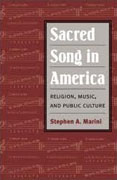Sacred Song in America
Stephen A. Marini
book reviews:
· general fiction
· chick lit/romance
· sci-fi/fantasy
· graphic novels
· nonfiction
· audio books
· author interviews
· children's books @
curledupkids.com
· DVD reviews @
curledupdvd.com
newsletter
win books
buy online
links
home
for authors
& publishers
for reviewers

 |
Sacred Song in America: Religion, Music, and Public Culture (Public Express Religion America) Stephen A. Marini University of Illinois Press Paperback 416 pages December 2010 |
|
When people sing and dance sacred music, even if they do not “believe” in the words, they gain entry into a sacred space. The rituals associated with singing are part of the key that unlocks the gate to that space. This is a major theme of this deeply researched analysis of different forms of American sacred music, whether it be the church music of the African American tradition, the “high lonesome” sound of bluegrass gospel, or the tantalizing beat of the drum that accompanies Native American dance and chant.
Marini also attended services in black churches, where he found that repetition and rhythm are still a part of the song culture, along with something Louis Gates has identified as “signifyin(g)” inherent in the freedom of the call that evokes the response both in song and in prayer. When the caller is moved by the spirit, s/he is free to signify, and the congregation tunes in to this freedom and its layered meaning. Through the ritual of call and response, the singers are released from everyday reality and concerns, drawing on “Christianity’s power to heal, transform and remedy” the community’s legacy of sorrow and suffering. Other religious musical rituals and evolutions include New Age and Neo-Paganism, Mormons and their music, the Jewish music revival, charismatic Catholic songs, and music of the Hispanic Southwest. The musical forms are looked at both from their commercial content - as especially is the case with bluegrass-country derived hymns/gospel songs - and from the point of the view of their individual cultural bases. In his introduction, Marini says that “sacred song must be observed in performance in order to adequately describe it.” After that, we can apply various tools of religion, sociology and the like to the analysis. But primary among the various tasks is to understand what the songs mean to the singers, and Marini puts that before our eyes in a compelling way, concluding that although we can continue to examine sacred song, it will continue to elude our attempts at classification (and almost certainly will rise above the attempts of others at commercialization). As Marini states, “…In the end it is the living reality of human religiousness that moves the believer to sing and compels the scholar to understand.” Originally published on Curled Up With A Good Book at www.curledup.com. © Barbara Bamberger Scott, 2011 |
|
|
|
 Click here to learn more about this month's sponsor! |
|
| fiction · sf/f · comic books · nonfiction · audio newsletter · free book contest · buy books online review index · links · · authors & publishers reviewers |
|
| site by ELBO Computing Resources, Inc. | |
 Stephen A Marini is
also the author of Radical Sects of Revolutionary New England and a Professor of Christian
studies, American religion and ethics at Wellesley College. He is also a self-confessed practitioner of the art of shape-note, or Sacred Harp singing, a fine example of how a type of religious music has evolved far past its simple,
Southern agrarian roots to attract educated folk from the North who “have come to Sacred Harp through academic or musical exposure, not through families or congregations.” Though both groups enjoy the sense of the songs while they are singing them together, arguably the
Northern proponents are experiencing something quite different from the deeply rooted song carriers of the
South who grew up with the songs as part of their home and church life. Yet both groups may find themselves within the square of sound in a plain little church giving and receiving something that could be grace
(or merely endorphins) as they exuberantly sing.
Stephen A Marini is
also the author of Radical Sects of Revolutionary New England and a Professor of Christian
studies, American religion and ethics at Wellesley College. He is also a self-confessed practitioner of the art of shape-note, or Sacred Harp singing, a fine example of how a type of religious music has evolved far past its simple,
Southern agrarian roots to attract educated folk from the North who “have come to Sacred Harp through academic or musical exposure, not through families or congregations.” Though both groups enjoy the sense of the songs while they are singing them together, arguably the
Northern proponents are experiencing something quite different from the deeply rooted song carriers of the
South who grew up with the songs as part of their home and church life. Yet both groups may find themselves within the square of sound in a plain little church giving and receiving something that could be grace
(or merely endorphins) as they exuberantly sing.